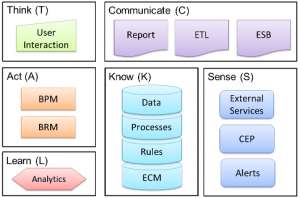Data Unleashed™. The name expresses a vision of data freed from its shackles so that it can be quickly and iteratively accessed, related, studied and expanded. In order to achieve that vision, the process of combining, or federating, the data must be lightweight. That is, the approach must facilitate rapid data set expansion and on-the-fly relationship changes so that we may quickly derive insights. Conversely, the process must not include a significant investment in data structure design since agility requires that we avoid a rigid structure.
Over the past year Blue Slate Solutions has been advancing its processes and technology to support this vision, which comprises the integration between components in our Cognitive Corporation® framework. More recently we have invested in an innovation development project to take our data integration experiences and semantic technology expertise and create a service offering backed by a lightweight data federation platform. Our platform, Data Unleashed™, enables us to partner with customers who are seeking an agile, lightweight enhancement to traditional data warehousing.
I want to emphasize that we believe that the Data Unleashed™ approach to data federation works in tandem with traditional Data Warehouses (DW) and other well-defined data federation options. It offers agility around data federation, benefiting focused data needs for which warehouses are overkill while supporting a process for iteratively deriving value using a lightweight data warehouse™ approach that informs a broader warehousing solution.
At a couple of points below I emphasize differences between Data Unleashed™ and a traditional DW. This is not meant to disparage the value of a DW but to explain why we feel that Data Unleashed™ adds a set of data federation capabilities to those of the DW.
As an aside, Blue Slate is producing a set of videos specifically about semantic technology, which is a core component of Data Unleashed™. The video series, “Semantic Technology, An Enterprise Introduction,” will be organized in two tracks, business-centric and technology-centric. Our purpose in creating these is to promote a holistic understanding of the value that semantics brings to an organization. The initial video provides an overview of the series.
What is Data Unleashed™ All About?
Data Unleashed™ is based on four key premises:
- the variety of data and data sources that are valuable to a business continue to grow;
- only a subset of the available data is valuable for a specific reporting or analytic need;
- integration and federation of data must be based on meaning in order to support new insights and understanding; and
- lightweight data federation, which supports rapid feedback regarding data value, quality and relationships speeds the process of developing a valuable data set.
I’ll briefly describe our thinking around each of these points. Future posts will go into more depth about Data Unleashed™ as well. In addition, several Blue Slate leaders will be posting their thoughts about this offering and platform.
 I am thrilled to have been invited back to participate at the Semantic Technology and Business (SemTechBiz) conference. This is the premier US conference for learning about, exploring and getting your hands on semantic technology. I’ll be part of a Blue Slate team (including Scott Van Buren and Michael Delaney) who will be conducting a half-day hands-on workshop, Integrating Data Using Semantic Technology, on August 19, 2014. Our mission is to have participants use semantic technology to integrate, federate and perform analysis across several data sources.
I am thrilled to have been invited back to participate at the Semantic Technology and Business (SemTechBiz) conference. This is the premier US conference for learning about, exploring and getting your hands on semantic technology. I’ll be part of a Blue Slate team (including Scott Van Buren and Michael Delaney) who will be conducting a half-day hands-on workshop, Integrating Data Using Semantic Technology, on August 19, 2014. Our mission is to have participants use semantic technology to integrate, federate and perform analysis across several data sources.